Hi folks,
This week I put you up against Stephanie from the marketing team. I gave her a bit of advantage by not being too hard-code FME. So let's get down to it and see the answers and how you did.
Answers1) FME has been translated into a number of local languages. Which language is NOT listed as an available translation on the Safe website?
- Chinese
- French
- German
- Greek
- Japanese
I was a bit surprised to see you all got this correct! But only a bit, because I suppose Greece is not a known hot-spot for FME. So, yes, the answer is Greece.
You can see what languages we do support by checking out the tech specifications page on our web site:
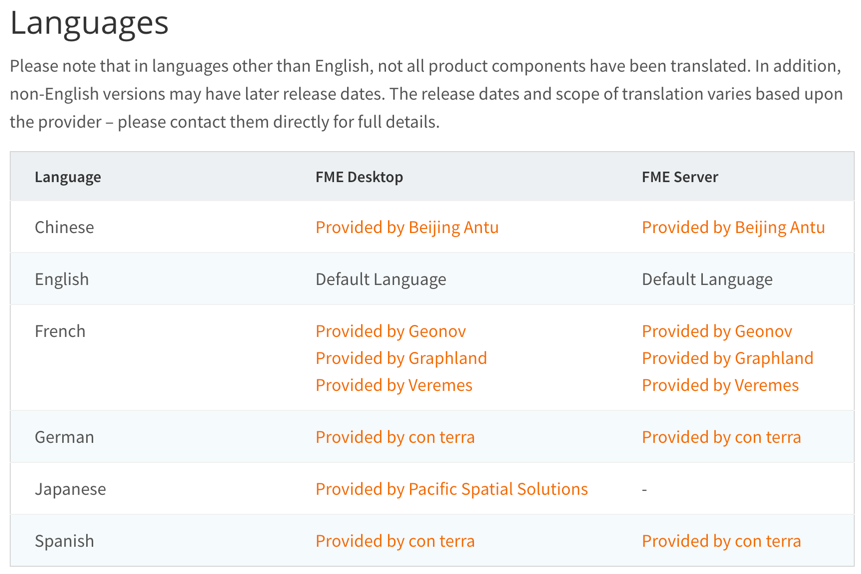
That has to be one of the harder pages to find, even when you know it exists; unless I'm really not looking very well.
Stephanie's Answer: Greek (Correct)
2) Safe's head office is located on 137A Street in Surrey, BC. What is the building number?
- 1313
- 9639
- 1060
- 7445
- 221B
We are located at.... 9639 137A Street. That's on our web site too, if you went and looked it up:
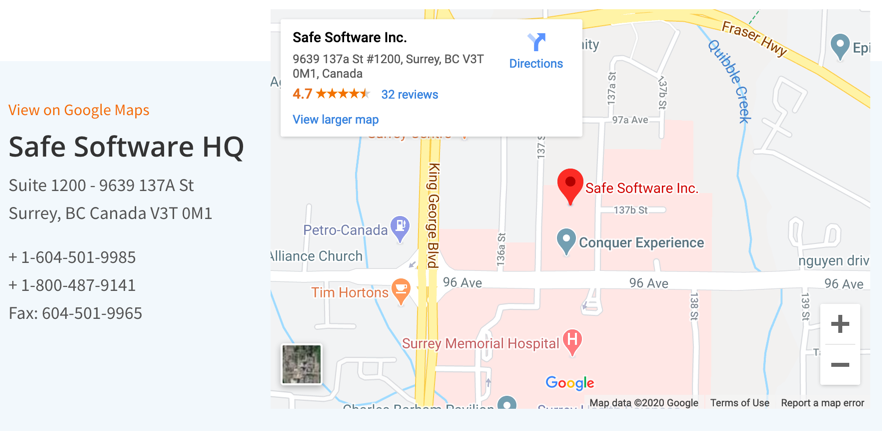
What about the other numbers? You know I didn't pick them at random!
- 1313: The number of the Munsters, at 1313 Mockingbird Lane; although apparently Donald Duck also lives at a 1313 (Webfoot Street)
- 1060: Jake Blues in the film The Blues Brothers gives his address as 1060 West Addison. In actual fact, that's the address of the Chicago Cubs Wrigley Field.
- 7445: That's Safe's old address, 7445 132nd Street
- 221B: Ah, you got to know who this is, right? It's so... elementary!
Stephanie's Answer: 9639 (Correct)
3) I have a spatial dataset containing all the neighbourhoods in Vancouver. I wish to put a bounding box around the whole of Vancouver. Which transformer do I use?
- BoundingBoxAccumulator
- BoundingBoxReplacer
- BoundsExtractor
- NeighborhoodAggregator
- YVRCityExtentsBuilder
So when you want a bounding box around a single feature, the BoundingBoxReplacer is the one to use; but for a bounding box around multiple features, use the BoundingBoxAccumulator.
The BoundsExtractor returns the coordinates of the extents, but not the bounding box.
The NeighborAggregator... does exist! It's one of those transformers I never remember until I see it listed somewhere. It basically groups (or aggregates) features together based on their proximity to each other. I doubt it's used much, but I can see it might be useful occasionally.
And the YVRCityExtentsBuilder is a fiction of my imagination, which is why no-one selected it.
Stephanie's Answer: NeighbourhoodAggregator (Incorrect)
4) The last FME World Tour virtual event for 2020 just took place. Where?
- Croatia
- China
- Poland
- Algeria
- Sweden
Another "country" question and this time the answer is China. They had a series of 5 events I believe, that finished last week:

I should note that there are still some "in-person" events on the calendar for later this year, so we'll see if they go ahead.
Also, presentations from various virtual tour events are also appearing online now. You can find the Safe-hosted ones on our web site, I see the 1Spatial UK events are online too, as are Locus' presentations, and if you know of any more, please post a link below so I can share it.
Stephanie's Answer: China (Correct)
5) I'm creating a dynamic workspace using Schema Features. How do I set the permitted geometry for the schema?
- By setting the format attribute called fme_geometry
- By creating a plain attribute called dynamic_geometry
- By creating a list attribute called fme_geometry{}
- Using an XQuery in the GeometryCoercer transformer
- You can't. You have to use "First Feature Sets Geometry"
Ah, dynamic translations. They keep on giving me some great questions. Usually, geometry type comes from the first feature or is set as a static value. In fact, it's usually not even needed, because so few formats care about geometry types being mixed in a single feature type.
But if you do need to set it, and you are using Schema Features, then you set it with a list attribute called fme_geometry{}
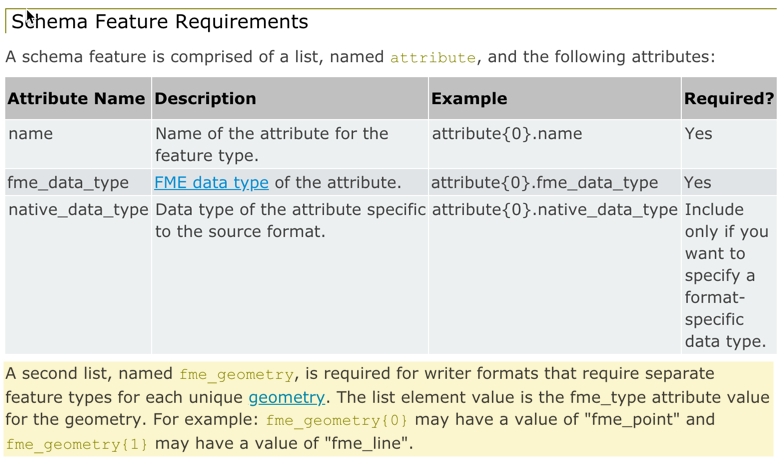
It's a list because you might be writing multiple tables and want a different geometry type for each.
Interestingly I also found native_data_type, which is what you use when you want to specify attribute data types in their native form, rather than using FME terminology.
Stephanie's Answer: By creating a plain attribute called dynamic_geometry (Incorrect)
6) What does the latest Bot at Safe do?
- Picks a random Safer to take the FME Quiz
- Picks two random Safers to play online chess against each other
- Picks three random Safers to take a virtual coffee break together
- Picks four random Safers to take part in a team-building event
- Picks five random Safers to test a new item of FME functionality
These days, while we're often working mostly at home, it can be a bit lonely. It's not just the work conversation, but chatting while on a break that you miss too. So my colleague @jlutherthomas developed a new bot at Safe to pair three people together for a virtual coffee break.

As you can see, it's Slack-based, but I've no doubt that there's FME Server somewhere underneath. I clicked the coffee icon and now I am paired up with two colleagues for an online chat later this afternoon.
If you're interested in how it works, I'm sure Jen will share the secret.
Stephanie's Answer: Picks a random Safer to take the FME Quiz (Incorrect)
ScoresWell. How did you do? Let's see:
- Quiz Week: 30 (June 1/2020)
- Number of Entries: 25
- Best Score: 6
- Worst Score: 1
- Average Score: 4.44
- Perfect Scores: 4
- Easiest Question: 1 (25)
- Hardest Question: 5 (10)
Four perfect scores (@jelle @erik_jan @danny and @srg) and an average of 4.44. Oh, if only Stephanie had known about the coffee bot! Never mind. So here's the weekly score:
- Beat Stephanie: 21
- Equalled Stephanie: 1
- Were Beaten by Stephanie: 3
The overall score is now...
- Users 16 Safers 7
Another victory for the users. Your table is now:
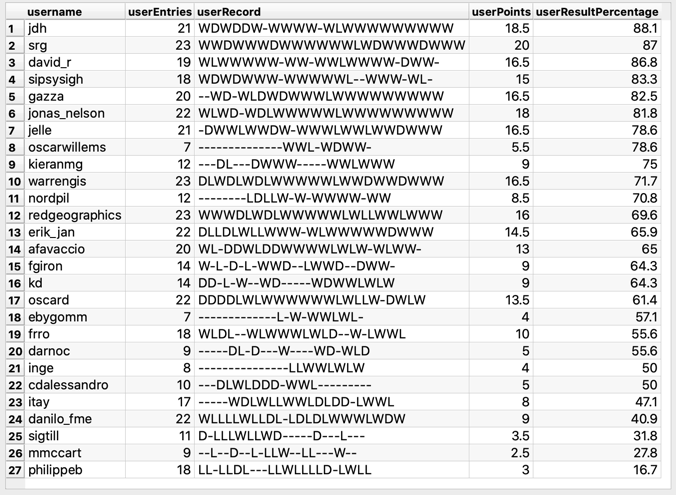
While ours is:
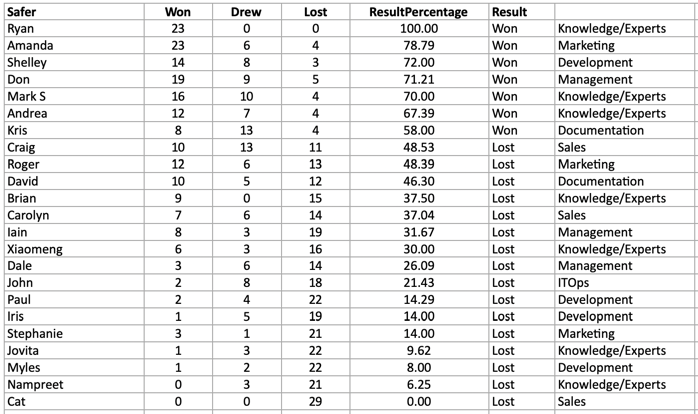
Well done folks. See you all next week.











